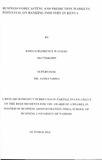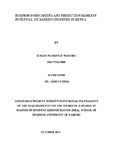| dc.description.abstract | The environment surrounding organizations is turbulent. for this reason forecasting techniques
have played a major role in sustaining them. TIle banking industry in Kenya is not also
exceptional due to the fast change in technology and infrastructure. This has made managers and
qualified professionals to be keen in matters conceming the extemal environment in order to
have a competitive advantage 0 er their competitors. There are a variety of forecasting
techniques in use however there is a major forecasting technique according to research that
outweighs the rest referred to as prediction Market.
Prediction market is a tool used to assemble and combine information using market ideologies
for the purpose of future predictions. It is cost effective to the organization in the short and long
run and produces accurate results irrespective of the number of participants. A small to big group
can produce the desired outcome. This project seeks to reveal the various literatures on
prediction Markets, highlighting theoretical contributions towards its effectiveness to aggregate
information. It also reveals the benefits, applications and model. Furthermore, it analysis how
knowledgeable and ready the banking industry in Kenya is towards the new concept.
The objective ofthis study was to fmd out the satisfaction of the present forecasting tools used
by the banks, determine the level of awareness of prediction markets and develop a prediction
market model that can be used to determine the readiness to adopt prediction market in the
Kenyan banking industry. This study used a cross sectional survey design. The target population
was senior managers in the marketing and research department from 50 licensed commercial
banks. This study was carried in Nairobi since all the commercial banks have their headquarters
in Nairobi. From the 50 licensed banks, the researcher selected one manager from each bank.
Therefore a sample of 35 respondents consisting of one respondent from each bank was used for
this study. A semi-structured questionnaire was used for this study. Data was analyzed using
descriptive statistics and multiple regression analysis. The descriptive analysis was used to test
the level of satisfaction of current forecasting tools and prediction market awareness. As per the
scale used, the level was average for both objectives. Multiple regression was used to test the
readiness to adopt prediction markets in the Kenyan banking industry. Management support was
found to be the only independent variable with a significant impact on readiness to adopt
prediction market (b=O.S69, p<O.OOl) when all the variables were entered into the regression
equation. Time spend (b=O.102, p=O.88S), accuracy (b=O.l82,p=O.798) and legal matters (b=O.180~p=0232)
did not meet the necessary criteria to significantly impact the dependent variable
(readiness to adopt prediction markets), so they played no role at this stage of the analysis
because the p>O.OS.
The study revealed that for prediction market model to be adopted management support was necessary and therefore other variables did not count. For this reason further research on other factors other than the ones used in this study need to be established. However, study will be of use to all businesses and academic fields and if well embraced, it will make them realize the opportunities they have severally missed out for lack of correct or enough information that is vital for decision making. | en_US |


